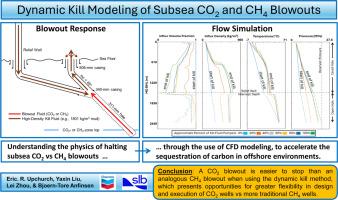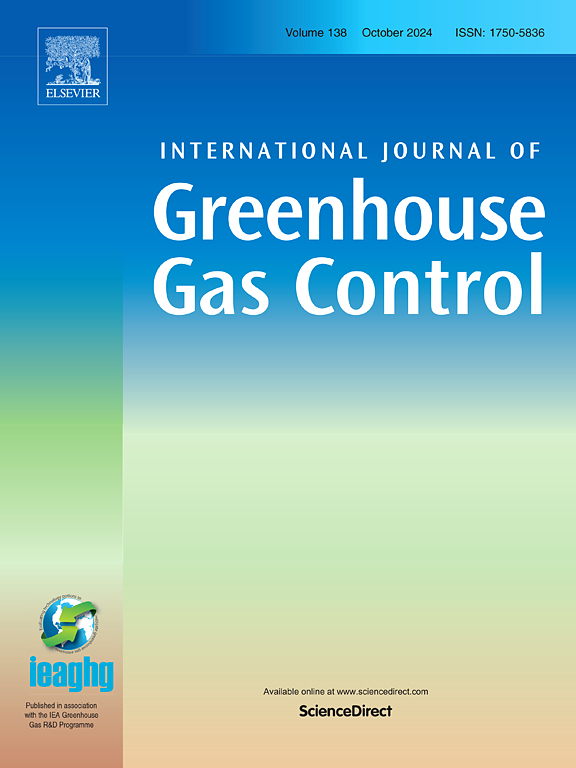海底CO2和CH4井喷的动态压井建模:区分因素及其对海上碳封存的影响
IF 5.2
3区 工程技术
Q2 ENERGY & FUELS
International Journal of Greenhouse Gas Control
Pub Date : 2025-10-01
DOI:10.1016/j.ijggc.2025.104486
引用次数: 0
摘要
这项研究的重点是了解使用动态压井方法阻止海底二氧化碳井喷的物理原理。计算流体动力学(CFD)模型复制了CO2的热物理性质。我们还分析了类似的CH4情景,并列分析了两种流体的影响。我们模拟了16种井喷/动态压井情景,代表了水深(305或762 m)、井喷速率(2.83或11.34 MMm3/d)、减压井拦截深度(1220或1830 m TVD BML)和储层流体(CO2或CH4)的所有组合。这定义了一个足够广泛的模拟空间,可以深入了解海底CO2井喷动态灭井的未定义方面,以及它们与CH4井喷的区别。当使用1801-kg/m3压井液时,CO2的热物理性质通常会将动态压井泵送速率降低到CH4井喷所需泵送速率的三分之一。压力升高时二氧化碳的相变是造成这种差异的主要原因。在动态压井过程中,井压的增加会导致CO2密度从68 kg/m3跃升至904 kg/m3,而CH4的密度则在22 kg/m3至192 kg/m3之间。这种密度-压力行为的根本差异导致CO2井喷通常比CH4井喷更容易被杀死。本文还详细介绍了CO2和CH4井喷动态杀伤的其他差异,如多相流行为,以解释它们的影响。我们还发现,较浅水域的二氧化碳井喷会在井口产生低于冰点的温度,导致冰和/或水合物的形成,这一结果可能会给海底井喷的整体响应带来意想不到的复杂性。本文章由计算机程序翻译,如有差异,请以英文原文为准。

Dynamic kill modeling of subsea CO2 and CH4 blowouts: Differentiating factors and their implications for offshore carbon sequestration
This study focusses on understanding the physics of halting subsea CO2 blowouts using dynamic-kill methods. A computational fluid dynamics (CFD) model that replicates the thermophysical properties of CO2 is used. We also analyze analogous CH4 scenarios, juxtaposing the impacts of both fluids.
We simulate sixteen blowout/dynamic-kill scenarios, representing all combinations of water depth (305 or 762 m), blowout rate (2.83 or 11.34 MMm3/d), relief well intercept depth (1220 or 1830 m TVD BML), and reservoir fluid (CO2 or CH4). This defines a sufficiently broad simulation space for gaining insight into the heretofore undefined aspects of dynamically killing subsea CO2 blowouts – and how they differ from CH4 blowouts.
CO2‘s thermophysical properties generally reduce dynamic kill pumping rates to one-third of that required for CH4 blowouts when using 1801-kg/m3 kill fluid. CO2 phase change at elevated pressures drives most of the difference. During a dynamic kill, increases in well pressure can cause CO2 density to jump from 68 to 904 kg/m3, while CH4 exhibits a modest 22 to 192 kg/m3 range. This radical difference in density-vs-pressure behavior results in CO2 blowouts being generally easier to kill than CH4 blowouts. Other differences in the dynamic killing of CO2 and CH4 blowouts, like multiphase flow behavior, are detailed in the paper to explain their impacts.
We also find that CO2 blowouts in shallower water can generate sub-freezing temperatures at the wellhead, resulting in ice and/or hydrate formation – a result that can introduce unintended complexity into the overall response to a subsea blowout.
求助全文
通过发布文献求助,成功后即可免费获取论文全文。
去求助
来源期刊
CiteScore
9.20
自引率
10.30%
发文量
199
审稿时长
4.8 months
期刊介绍:
The International Journal of Greenhouse Gas Control is a peer reviewed journal focusing on scientific and engineering developments in greenhouse gas control through capture and storage at large stationary emitters in the power sector and in other major resource, manufacturing and production industries. The Journal covers all greenhouse gas emissions within the power and industrial sectors, and comprises both technical and non-technical related literature in one volume. Original research, review and comments papers are included.

 求助内容:
求助内容: 应助结果提醒方式:
应助结果提醒方式:


